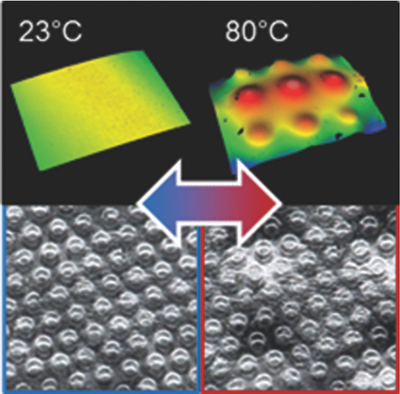当前位置:
X-MOL 学术
›
Adv. Funct. Mater.
›
论文详情
Our official English website, www.x-mol.net, welcomes your
feedback! (Note: you will need to create a separate account there.)
Temperature‐Induced Switchable Adhesion using Nickel–Titanium–Polydimethylsiloxane Hybrid Surfaces
Advanced Functional Materials ( IF 18.5 ) Pub Date : 2015-04-08 , DOI: 10.1002/adfm.201500437 Mareike Frensemeier 1 , Jessica S Kaiser 2 , Carl P Frick 3 , Andreas S Schneider 2 , Eduard Arzt 1 , Ray S Fertig 3 , Elmar Kroner 2
Advanced Functional Materials ( IF 18.5 ) Pub Date : 2015-04-08 , DOI: 10.1002/adfm.201500437 Mareike Frensemeier 1 , Jessica S Kaiser 2 , Carl P Frick 3 , Andreas S Schneider 2 , Eduard Arzt 1 , Ray S Fertig 3 , Elmar Kroner 2
Affiliation

|
A switchable dry adhesive based on a nickel–titanium (NiTi) shape‐memory alloy with an adhesive silicone rubber surface has been developed. Although several studies investigate micropatterned, bioinspired adhesive surfaces, very few focus on reversible adhesion. The system here is based on the indentation‐induced two‐way shape‐memory effect in NiTi alloys. NiTi is trained by mechanical deformation through indentation and grinding to elicit a temperature‐induced switchable topography with protrusions at high temperature and a flat surface at low temperature. The trained surfaces are coated with either a smooth or a patterned adhesive polydimethylsiloxane (PDMS) layer, resulting in a temperature‐induced switchable surface, used for dry adhesion. Adhesion tests show that the temperature‐induced topographical change of the NiTi influences the adhesive performance of the hybrid system. For samples with a smooth PDMS layer the transition from flat to structured state reduces adhesion by 56%, and for samples with a micropatterned PDMS layer adhesion is switchable by nearly 100%. Both hybrid systems reveal strong reversibility related to the NiTi martensitic phase transformation, allowing repeated switching between an adhesive and a nonadhesive state. These effects have been discussed in terms of reversible changes in contact area and varying tilt angles of the pillars with respect to the substrate surface.
中文翻译:

使用镍-钛-聚二甲基硅氧烷混合表面的温度诱导可切换粘合力
开发出一种基于镍钛 (NiTi) 形状记忆合金且具有粘性硅橡胶表面的可切换干粘合剂。尽管有几项研究调查了微图案、仿生粘合表面,但很少有研究关注可逆粘合。该系统基于镍钛合金中压痕诱导的双向形状记忆效应。NiTi 通过压痕和研磨进行机械变形训练,以产生温度诱导的可切换形貌,在高温下具有突起,在低温下具有平坦表面。经过训练的表面涂有光滑或图案化的粘合聚二甲基硅氧烷(PDMS)层,形成温度诱导的可切换表面,用于干粘合。粘合测试表明,温度引起的镍钛形貌变化会影响混合系统的粘合性能。对于具有光滑 PDMS 层的样品,从平坦状态到结构化状态的转变使粘附力降低了 56%,而对于具有微图案 PDMS 层的样品,粘附力可切换近 100%。两种混合系统均表现出与镍钛马氏体相变相关的强大可逆性,允许在粘合状态和非粘合状态之间反复切换。已经根据接触面积的可逆变化和柱相对于基板表面的倾斜角度的变化来讨论这些效应。
更新日期:2015-04-08
中文翻译:

使用镍-钛-聚二甲基硅氧烷混合表面的温度诱导可切换粘合力
开发出一种基于镍钛 (NiTi) 形状记忆合金且具有粘性硅橡胶表面的可切换干粘合剂。尽管有几项研究调查了微图案、仿生粘合表面,但很少有研究关注可逆粘合。该系统基于镍钛合金中压痕诱导的双向形状记忆效应。NiTi 通过压痕和研磨进行机械变形训练,以产生温度诱导的可切换形貌,在高温下具有突起,在低温下具有平坦表面。经过训练的表面涂有光滑或图案化的粘合聚二甲基硅氧烷(PDMS)层,形成温度诱导的可切换表面,用于干粘合。粘合测试表明,温度引起的镍钛形貌变化会影响混合系统的粘合性能。对于具有光滑 PDMS 层的样品,从平坦状态到结构化状态的转变使粘附力降低了 56%,而对于具有微图案 PDMS 层的样品,粘附力可切换近 100%。两种混合系统均表现出与镍钛马氏体相变相关的强大可逆性,允许在粘合状态和非粘合状态之间反复切换。已经根据接触面积的可逆变化和柱相对于基板表面的倾斜角度的变化来讨论这些效应。











































 京公网安备 11010802027423号
京公网安备 11010802027423号